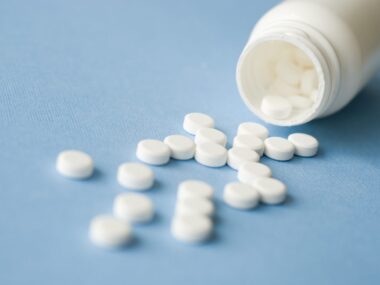Treating ‘Bad Cholesterol’ May Offer Way of Targeting PF, Study Finds
Written by |

Problems in the metabolism of low-density lipoprotein (LDL) — also known as “bad cholesterol” — and its receptor contribute to changes in lung cells that ultimately lead to pulmonary fibrosis (PF), an analysis of fibrotic lung tissue and cell and animal models suggests.
Notably, a combination of two approved treatments to lower LDL, including statins, restored its receptor’s function and eased fibrosis, demonstrating for the first time that “lung fibrosis can be alleviated with a pharmacological intervention that targets LDL–LDLR [LDL receptor] metabolism,” the scientists wrote.
These findings were in the study, “LDLR dysfunction induces LDL accumulation and promotes pulmonary fibrosis,” published in the journal Clinical and Translational Medicine.
In PF, the thin walls of the lung’s tiny air sacs where gas exchanges take place, called alveoli, start to scar and thicken, leading to shortness of breath. Studies indicate that alveolar type II cells (ATII) lining the alveoli are an early driver of lung scarring, or fibrosis.
The low-density lipoprotein receptor (LDLR) is a protein on the surface of ATII cells that helps internalize LDL particles — small protein packets that transport fat and fatty-like substances (lipids), such as cholesterol, throughout the body. In ATII cells, low-density lipoprotein supplies components for the production of a protective lubricant that is secreted in the alveoli to facilitate gas exchange.
Emerging evidence suggests that a disruption in the relationship between LDL and its receptor on ATII cells may contribute to PF.
A research team led by investigators at Fudan University in China conducted a series of experiments focusing on the LDL receptor in cell and mouse models of PF, and they examined fibrotic lung tissue samples from idiopathic pulmonary fibrosis (IPF) patients.
Assessments of patient tissue showed low levels of LDL receptor gene activity and its receptor protein compared with samples from healthy people (controls). Findings were similar in lung tissue isolated from people with systemic scleroderma, a fibrotic disease caused by an altered immune response.
In IPF samples, the LDL receptor was expressed, or produced, at significantly lower levels in alveolar type II cells as well as in fibroblast cells — a cell found in connective tissue that plays a central role in fibrosis. Blood tests also confirmed that, compared with controls, IPF patients had significantly higher LDL levels.
In the same way, mice with bleomycin-induced lung fibrosis also had high LDL levels and low LDL receptor expression in lung tissues, again particularly in ATII and fibroblast cells. Similar results were seen in three other mouse models of lung fibrosis, suggesting that “LDL–LDLR expression was persistently disrupted,” the researchers wrote.
Induced fibrosis in mice lacking the gene that encodes for the LDL receptor led to a significant increase in areas of fibrotic tissue and greater expression of pro-fibrotic genes compared with PF-induced but still healthy mice. Notably, mice lacking the LDL receptor showed fibrosis as early as seven days, “suggesting that mice with [LDL receptor] deficiency are more susceptible to [bleomycin]-induced PF,” the team wrote.
Mice lacking the LDL receptor also had increased numbers of immune cells in their lungs and higher levels of pro-inflammatory signaling proteins. Further, the number of ATII cells that underwent programmed cell death (apoptosis) markedly rose in these receptor-deficient mice compared with the PF-induced healthy mice.
In ATII cells and endothelial cells lining blood vessels isolated from the PF-induced and LDL receptor-deficient mice, there was an increase in a marker for activated fibroblast cells known to generate scar tissue components. This increase in fibroblast-like ATII and endothelial cells in these mice was associated with a decrease in the LDL receptor.
Atorvastatin (sold under the brand name Lipitor) is a statin-based medicine commonly prescribed to lower cholesterol levels. It works by enhancing the expression of LDL receptors and lowering cholesterol, particularly LDL. Alirocumab (sold under the brand name Praluent) is an antibody-based, second-line treatment for high cholesterol approved for use in adults with cardiovascular disease.
PF-induced mice treated with a combination of atorvastatin and alirocumab showed fewer fibrotic areas in lung tissue compared with mice treated with atorvastatin or alirocumab alone.
Combined treatment also lowered the number of immune cells in the lungs, normalized LDL levels, enhanced the expression of the LDL receptor, suppressed apoptosis, lowered fibroblast-like ATII and endothelial cell numbers, and lessened the risk of death.
Gene activity patterns in mice following treatment with atorvastatin and alirocumab were similar to those in healthy mice. Dual therapy restored genes with greater or lesser activity after PF induction to normal levels.
“This study revealed that abnormal LDL–LDLR metabolism stimulates apoptosis, increases fibroblast-like endothelial and ATII cells and activates fibroblasts, eventually leading to PF,” the scientists wrote.
“Additionally, we showed that atorvastatin and alirocumab restore LDLR expression and LDL levels, providing proof-of-concept that restoration of LDL–LDLR metabolism by pharmacological agents that target LDL and/or LDLR is a promising therapeutic strategy for fibrotic disorders,” they wrote.
Researchers also noted their findings are clinically relevant and that “clinicians should pay careful attention to LDL and LDLR levels in patients with PF or other pulmonary defects.”







